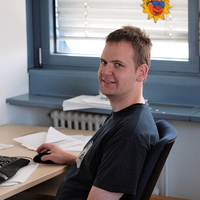
Dr.-Ing. Martin Kraus
Alumnus of the Pattern Recognition Lab of the Friedrich-Alexander-Universität Erlangen-Nürnberg
OCT Motion Correction and Signal Enhancement
High speed Optical Coherence Tomography (OCT) makes it possible to capture dense 3D volumes data with micron scale resolution within seconds. One application is the generation of in vivo images of the human retina. In the last few years this technique has found widespread used for diagnosis of eye diseases and disease progression monitoring. In typical OCT operation a volume is not generated instantly, but instead is composed of a 2D grid of 1D axial depth profiles which are scanned sequentially to form the volume. OCT volume scan times normally range from 2 to 4 seconds. Eye Movement during the scan leads to distortion of the image. The effect of these distortions is that quantitative measurements which are important for clinical practice are compromised.

The two images above show how motion distorts a volumetric data set. These images show an optic nerve head of a healthy subject and were captured on a high speed, high resolution OCT prototype device. On the left the en face fundus projection of the volume is shown. It can be seen that motion in the transverse direction causes discontinuities in the vessels originating in the optic nerve head. On the right a single slice of the volume in the slow scanning direction is shown. Here, axial motion imposes a wavy up and down pattern on the true structure.
In this project we register two or more volumes with orthogonal fast scanning axes to find and correct the unknown eye motion. Registration is performed by optimizing a global objective function using one displacement field for each input volume and special regularization. Afterwards, each volume is undistorted and a merged volume constructed which has lower noise levels, compared to the individual input volumes.
This way, motion in all three dimensions, slow drift and saccadic movement, can be corrected. These methods promise to facilitate the acquisition of large 3D-OCT data sets and improve measurement reproducibility without the need for active eye tracking or motion free reference images.

The above two images show corresponding views to the two images shown before. This volume, however, is produced by registering and merging six volumes like the one shown before. No motion artifacts are visible. In addition the signal to noise ratio of the cross-sectional slice is significantly increased.
This work is done in collaboration with Prof. James G. Fujiomoto's group at the Research Laboratory of Electronics at the Massachusetts Institute of Technology which originally introduced OCT and has since then been leading in OCT research.
We gratefully acknowledge funding for this project from the German Science Foundation within the project DFG-HO-1791/11-1.




